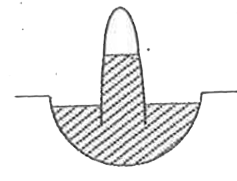Explain the following:
A very small amount of mercury on placing over a clean glass plate forms a tiny spherical ball.
Step by step video & image solution for Explain the following: A very small amount of mercury on placing over a clean glass plate forms a tiny spherical ball. by Physics experts to help you in doubts & scoring excellent marks in Class 8 exams.
Related Playlists
- BOOK - ICSECHAPTER - MATTER EXERCISE - EXERCISE 1.233videos
MATTER
- BOOK - ICSECHAPTER - MATTER EXERCISE - THEME ASSIGNMENT25videos
MATTER
- BOOK - ICSECHAPTER - LIGHT ENERGYEXERCISE - THEME ASSIGNMENT D. Statements given below are incorrect. Write the correct statements.7videos
LIGHT ENERGY
- BOOK - ICSECHAPTER - MODEL TEST PAPERS EXERCISE - Model Test Paper 2 (Section II)42videos
MODEL TEST PAPERS
Knowledge Check
- Question 1 - Select One
Four mutant strians of bacteria (1-4) all require substance S to grow (each strian is blocked at one step in the S-biosynthesis pathway). Four plates were prepared with mininmal medium and a trace of substance, S to allow a small amount of growth of mutant cells. on plate A, mutant cells of strain 1 were spred over entire surface of tha agar to form a thin law of bacteria. On plate B, the lawn was composed of mutant cells of strain 2, and so on. On each plate, cells of each of the four mutant types were inoculated over the lawn, as indicated in the figure by the circles. dark circles indicae excellent growth. A strain blocked at a later step in the S substance metabolic pathwa accumulates intermediates that can 'feed' a strain blocked at an earlier step.

What is the order of genes (1-4) in the metabolic pathway for synthesis of substance S ?A2→4→3→1B2→1→3→4C1→3→4→2D1→2→4→3 - Question 1 - Select One
Which of the following statements are correct ?
(i) When an animal hide, which has negatively charged particles , is soaked in tannin, which contains positively charged colloidal particles, mutual coagulation does not take place.
(ii) Photographic films are prepared by coating an emulsion of the light sensitive silver bromide in gelatin over glass plates or celluloid films.
(iii) Latex is a colloidal solution of rubber particles which are negatively charged.
(iv) In Cottrell precipitator , the smoke , before it comes out from the chimney, is led through a chamber containing plates having a charge opposite to that carried by smoke particles. The particles on coming in contact with these plates acquire some charge and do not get precipitated .A(i) and (iv) onlyB(ii) and (iii) onlyC(ii), (iii) and (iv) onlyDAll of these.
Similar Questions
Explain the following: A very samll amount of water on placing over a clean glass plate forms an oval shaped drop.
View SolutionA villager Itwari has a plot of land of the shape of a quadrilateral. The Gram Panchayat of the village decided to take over some portion of plot from one of the corners to construct a Health centre. Itwari agrees to the above proposal with the condition that he should be given equal amount of land in lieu of his land adjoining his plot so as to form a triangular plot. Explain how his proposal will be implemented.
View SolutionA villager Itwari has a plot of land of the shape of a quadrilateral. The Gram Panchayat of the village decided to take over some portion of plot from one of the corners to construct a health centre. Itwari agrees to the above proposal with the condition that he should be given equal amount of land in lieu of his land adjoining his plot so as to form a triangular plot. Explain how his proposal will be implemented.
View SolutionWhen mercury is dropped over a glass surface the globules are spherical which is due to its
View SolutionWhich of the following tissues is present in maximum amount, joins differet tissues, forms the packing between them and helps to keep the organs in place and normal shape ?
View SolutionWrite True or False and justify your answer for the following:
A solid cylinder of radius r and height h is placed over other cylinder same height and radius . The total surface area of the shape so formed is 4πrh+4πr2.View SolutionTorricelli was the first do devise an experiment for measuring atmospheric pressure . He took calibrated hard glass tube , 1 m in lengt and of uniform cross section , closed at one end . He filled the whole tube with dry mercury taking care than no air or water droplets remain inside the tube , closed the opposite end of the tube tightly with thumb and inverted it . He put this inverted mercury tube into a mercury through , taking care that the end of the tube remains inside the mercury through , An interesting thing was noticed . Mercury in the tube fell down at first and then stopped at a particular position . The height was 76 cm above the free surface of mercury in the through . When the given tube was inclined or lowered in the mercury trough , the vertical haight of mercury level in the tube was always found constant .
Torricelli explained this by saying that the free surface of mrcury in the trough . Hence , the hydrostatic pressure exerted by the trough measures the atmospheric pressure .

If a small hole is made at point P in the barometer tube , then
 View Solution
View SolutionA uniformly conducting wire is bent to form a ring of mass 'm' and radius 'r', and the ring is placed on a rough horizontal surface with its plane horizontal. There exists a uniform and constant horizontal magnetic field of induction B. Now a charge q is passed through the ring in a very small time interval Δt. As a result the ring ultimately just becomes vertical. Calculate the value of g(acceleration due to gravity) in terms of other given quantities. Assume that friction is sufficient to prevent slipping and ignore any loss in energy.
View Solution

